check engine BUICK LUCERNE 2007 Owner's Guide
[x] Cancel search | Manufacturer: BUICK, Model Year: 2007, Model line: LUCERNE, Model: BUICK LUCERNE 2007Pages: 496, PDF Size: 2.77 MB
Page 351 of 496
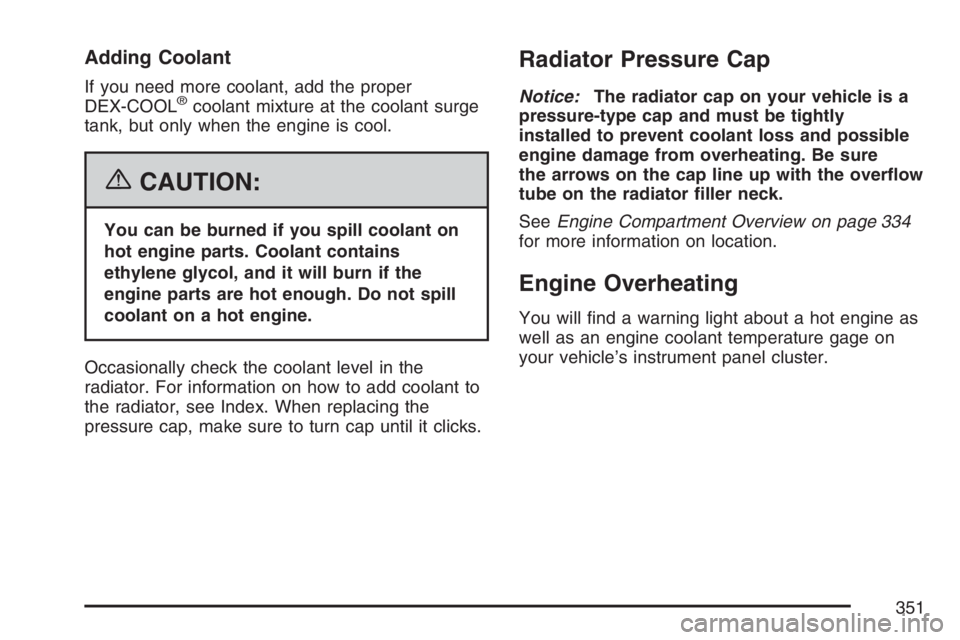
Adding Coolant
If you need more coolant, add the proper
DEX-COOL®coolant mixture at the coolant surge
tank, but only when the engine is cool.
{CAUTION:
You can be burned if you spill coolant on
hot engine parts. Coolant contains
ethylene glycol, and it will burn if the
engine parts are hot enough. Do not spill
coolant on a hot engine.
Occasionally check the coolant level in the
radiator. For information on how to add coolant to
the radiator, see Index. When replacing the
pressure cap, make sure to turn cap until it clicks.
Radiator Pressure Cap
Notice:The radiator cap on your vehicle is a
pressure-type cap and must be tightly
installed to prevent coolant loss and possible
engine damage from overheating. Be sure
the arrows on the cap line up with the over�ow
tube on the radiator �ller neck.
SeeEngine Compartment Overview on page 334
for more information on location.
Engine Overheating
You will �nd a warning light about a hot engine as
well as an engine coolant temperature gage on
your vehicle’s instrument panel cluster.
351
Page 355 of 496
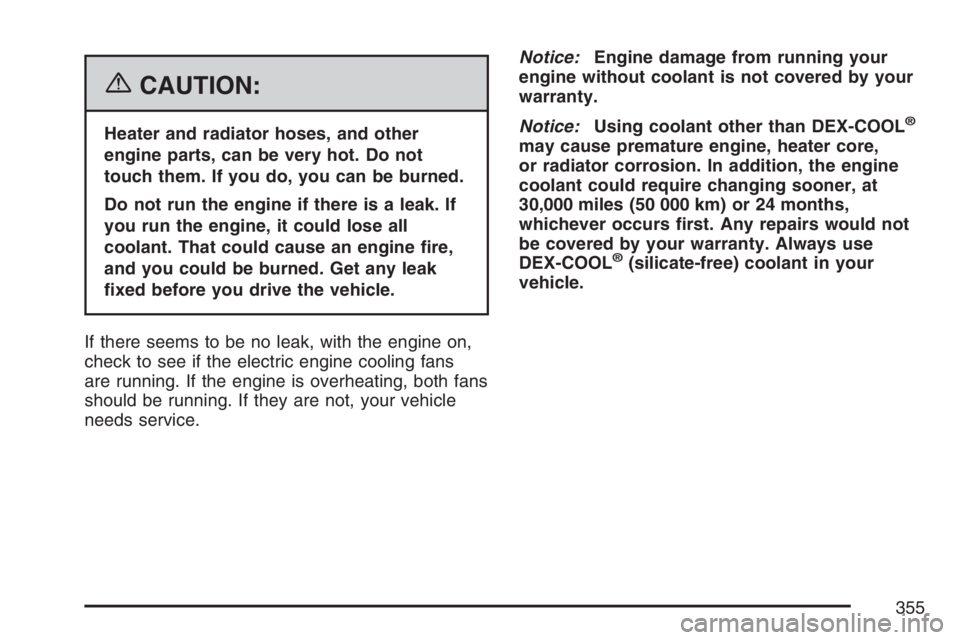
{CAUTION:
Heater and radiator hoses, and other
engine parts, can be very hot. Do not
touch them. If you do, you can be burned.
Do not run the engine if there is a leak. If
you run the engine, it could lose all
coolant. That could cause an engine �re,
and you could be burned. Get any leak
�xed before you drive the vehicle.
If there seems to be no leak, with the engine on,
check to see if the electric engine cooling fans
are running. If the engine is overheating, both fans
should be running. If they are not, your vehicle
needs service.Notice:Engine damage from running your
engine without coolant is not covered by your
warranty.
Notice:Using coolant other than DEX-COOL®
may cause premature engine, heater core,
or radiator corrosion. In addition, the engine
coolant could require changing sooner, at
30,000 miles (50 000 km) or 24 months,
whichever occurs �rst. Any repairs would not
be covered by your warranty. Always use
DEX-COOL
®(silicate-free) coolant in your
vehicle.
355
Page 361 of 496
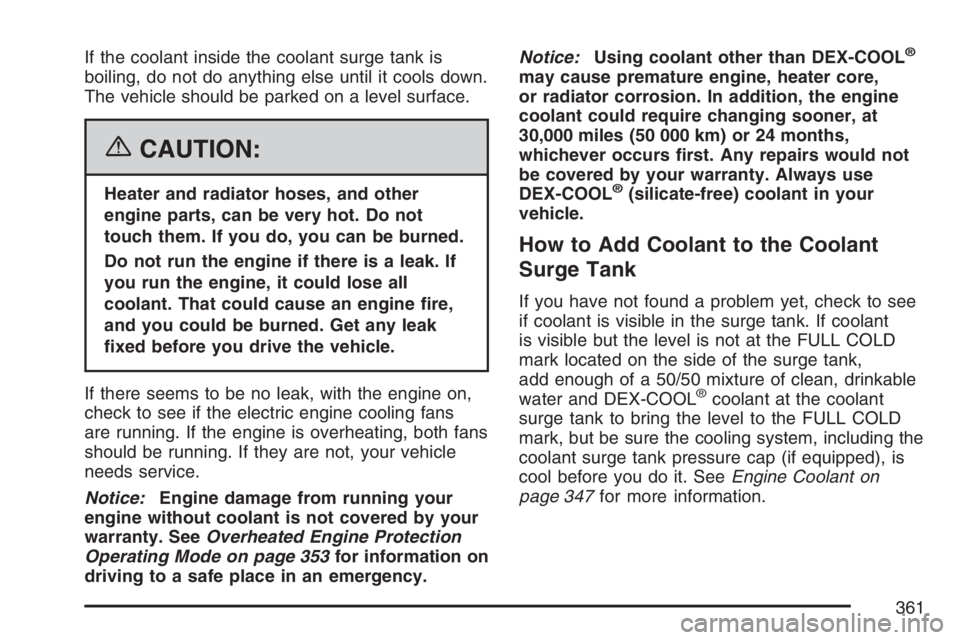
If the coolant inside the coolant surge tank is
boiling, do not do anything else until it cools down.
The vehicle should be parked on a level surface.
{CAUTION:
Heater and radiator hoses, and other
engine parts, can be very hot. Do not
touch them. If you do, you can be burned.
Do not run the engine if there is a leak. If
you run the engine, it could lose all
coolant. That could cause an engine �re,
and you could be burned. Get any leak
�xed before you drive the vehicle.
If there seems to be no leak, with the engine on,
check to see if the electric engine cooling fans
are running. If the engine is overheating, both fans
should be running. If they are not, your vehicle
needs service.
Notice:Engine damage from running your
engine without coolant is not covered by your
warranty. SeeOverheated Engine Protection
Operating Mode on page 353for information on
driving to a safe place in an emergency.Notice:Using coolant other than DEX-COOL
®
may cause premature engine, heater core,
or radiator corrosion. In addition, the engine
coolant could require changing sooner, at
30,000 miles (50 000 km) or 24 months,
whichever occurs �rst. Any repairs would not
be covered by your warranty. Always use
DEX-COOL
®(silicate-free) coolant in your
vehicle.
How to Add Coolant to the Coolant
Surge Tank
If you have not found a problem yet, check to see
if coolant is visible in the surge tank. If coolant
is visible but the level is not at the FULL COLD
mark located on the side of the surge tank,
add enough of a 50/50 mixture of clean, drinkable
water and DEX-COOL
®coolant at the coolant
surge tank to bring the level to the FULL COLD
mark, but be sure the cooling system, including the
coolant surge tank pressure cap (if equipped), is
cool before you do it. SeeEngine Coolant on
page 347for more information.
361
Page 364 of 496
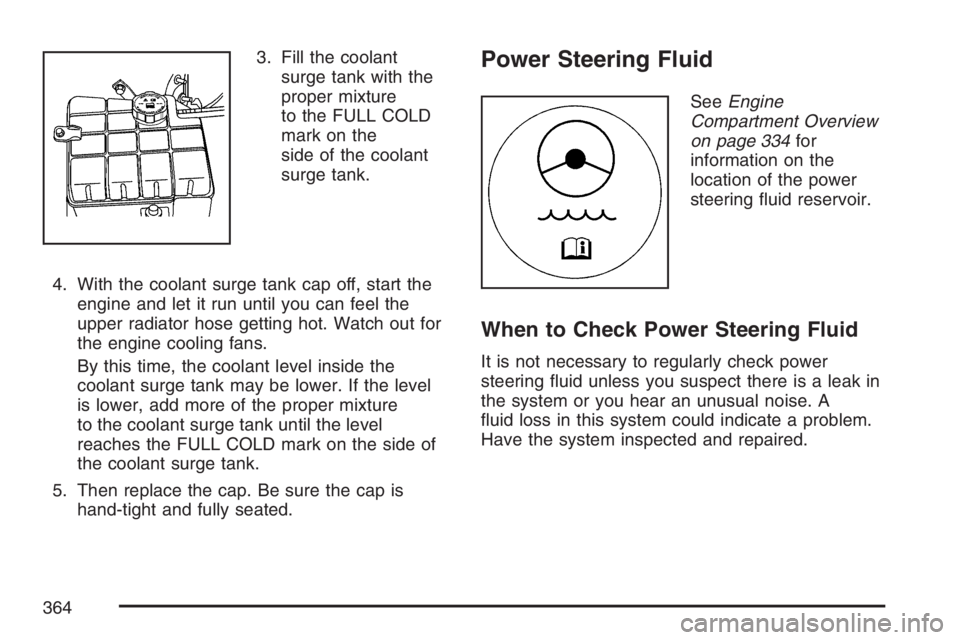
3. Fill the coolant
surge tank with the
proper mixture
to the FULL COLD
mark on the
side of the coolant
surge tank.
4. With the coolant surge tank cap off, start the
engine and let it run until you can feel the
upper radiator hose getting hot. Watch out for
the engine cooling fans.
By this time, the coolant level inside the
coolant surge tank may be lower. If the level
is lower, add more of the proper mixture
to the coolant surge tank until the level
reaches the FULL COLD mark on the side of
the coolant surge tank.
5. Then replace the cap. Be sure the cap is
hand-tight and fully seated.Power Steering Fluid
SeeEngine
Compartment Overview
on page 334for
information on the
location of the power
steering �uid reservoir.
When to Check Power Steering Fluid
It is not necessary to regularly check power
steering �uid unless you suspect there is a leak in
the system or you hear an unusual noise. A
�uid loss in this system could indicate a problem.
Have the system inspected and repaired.
364
Page 365 of 496

How to Check Power Steering Fluid
To check the power steering �uid, do the following:
1. Turn the key off and let the engine
compartment cool down.
2. Wipe the cap and the top of the reservoir
clean.
3. Unscrew the cap and wipe the dipstick with a
clean rag.
4. Replace the cap and completely tighten it.
5. Remove the cap again and look at the
�uid level on the dipstick.
The level should be at the FULL COLD mark. If
necessary, add only enough �uid to bring the level
up to the mark.
What to Use
To determine what kind of �uid to use, see
Recommended Fluids and Lubricants on page 452.
Always use the proper �uid. Failure to use the
proper �uid can cause leaks and damage hoses
and seals.
Windshield Washer Fluid
What to Use
When you need windshield washer �uid, be sure
to read the manufacturer’s instructions before
use. If you will be operating your vehicle in an area
where the temperature may fall below freezing,
use a �uid that has sufficient protection against
freezing.
365
Page 375 of 496

CAUTION: (Continued)
But if a battery has �ller caps, be sure the
right amount of �uid is there. If it is low,
add water to take care of that �rst. If you
do not, explosive gas could be present.
Battery �uid contains acid that can burn
you. Do not get it on you. If you
accidentally get it in your eyes or on your
skin, �ush the place with water and get
medical help immediately.
{CAUTION:
Fans or other moving engine parts can
injure you badly. Keep your hands away
from moving parts once the engine is
running.5. Check that the jumper cables do not have
loose or missing insulation. If they do, you
could get a shock. The vehicles could
be damaged too.
Before you connect the cables, here are some
basic things you should know. Positive (+)
will go to positive (+) or to a remote
positive (+) terminal if the vehicle has one.
Negative (−) will go to a heavy, unpainted
metal engine part or to a remote negative (−)
terminal if the vehicle has one.
Do not connect positive (+) to negative (−)or
you will get a short that would damage
the battery and maybe other parts too. And do
not connect the negative (−) cable to the
negative (−) terminal on the dead battery
because this can cause sparks.
6. Connect the red positive (+) cable to the
positive (+) terminal of the dead battery.
Use a remote positive (+) terminal if
the vehicle has one.
7. Do not let the other end touch metal. Connect
it to the positive (+) terminal of the good
battery. Use a remote positive (+) terminal if
the vehicle has one.
375
Page 428 of 496
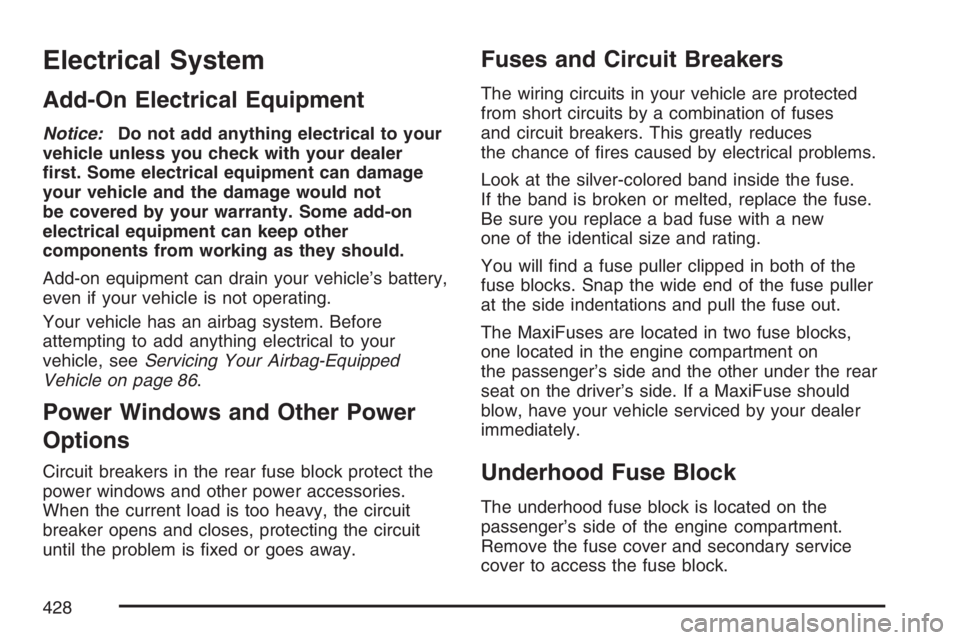
Electrical System
Add-On Electrical Equipment
Notice:Do not add anything electrical to your
vehicle unless you check with your dealer
�rst. Some electrical equipment can damage
your vehicle and the damage would not
be covered by your warranty. Some add-on
electrical equipment can keep other
components from working as they should.
Add-on equipment can drain your vehicle’s battery,
even if your vehicle is not operating.
Your vehicle has an airbag system. Before
attempting to add anything electrical to your
vehicle, seeServicing Your Airbag-Equipped
Vehicle on page 86.
Power Windows and Other Power
Options
Circuit breakers in the rear fuse block protect the
power windows and other power accessories.
When the current load is too heavy, the circuit
breaker opens and closes, protecting the circuit
until the problem is �xed or goes away.
Fuses and Circuit Breakers
The wiring circuits in your vehicle are protected
from short circuits by a combination of fuses
and circuit breakers. This greatly reduces
the chance of �res caused by electrical problems.
Look at the silver-colored band inside the fuse.
If the band is broken or melted, replace the fuse.
Be sure you replace a bad fuse with a new
one of the identical size and rating.
You will �nd a fuse puller clipped in both of the
fuse blocks. Snap the wide end of the fuse puller
at the side indentations and pull the fuse out.
The MaxiFuses are located in two fuse blocks,
one located in the engine compartment on
the passenger’s side and the other under the rear
seat on the driver’s side. If a MaxiFuse should
blow, have your vehicle serviced by your dealer
immediately.
Underhood Fuse Block
The underhood fuse block is located on the
passenger’s side of the engine compartment.
Remove the fuse cover and secondary service
cover to access the fuse block.
428
Page 437 of 496
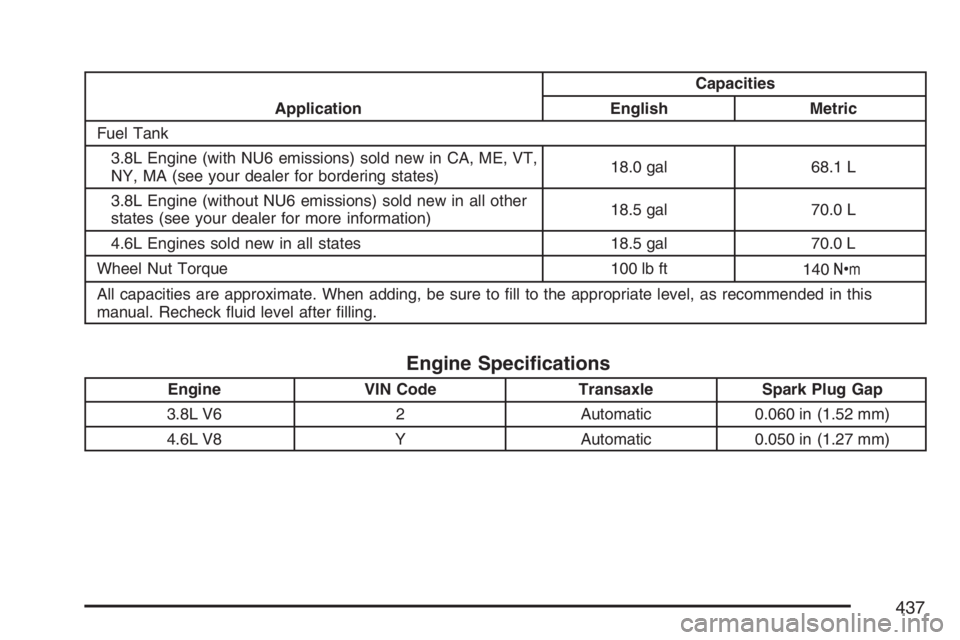
ApplicationCapacities
English Metric
Fuel Tank
3.8L Engine (with NU6 emissions) sold new in CA, ME, VT,
NY, MA (see your dealer for bordering states)18.0 gal 68.1 L
3.8L Engine (without NU6 emissions) sold new in all other
states (see your dealer for more information)18.5 gal 70.0 L
4.6L Engines sold new in all states 18.5 gal 70.0 L
Wheel Nut Torque 100 lb ft
140Y
All capacities are approximate. When adding, be sure to �ll to the appropriate level, as recommended in this
manual. Recheck �uid level after �lling.
Engine Speci�cations
Engine VIN Code Transaxle Spark Plug Gap
3.8L V6 2 Automatic 0.060 in (1.52 mm)
4.6L V8 Y Automatic 0.050 in (1.27 mm)
437
Page 439 of 496

Maintenance Schedule................................ 440
Introduction............................................... 440
Maintenance Requirements........................ 440
Your Vehicle and the Environment............ 440
Using the Maintenance Schedule............... 440
Scheduled Maintenance............................. 442
Additional Required Services..................... 444
Maintenance Footnotes.............................. 446Owner Checks and Services..................... 448
At Each Fuel Fill....................................... 448
At Least Once a Month............................. 449
At Least Once a Year............................... 449
Recommended Fluids and Lubricants........ 452
Normal Maintenance Replacement Parts ... 453
Engine Drive Belt Routing......................... 454
Maintenance Record.................................. 455
Section 6 Maintenance Schedule
439
Page 440 of 496

Maintenance Schedule
Introduction
Important: Keep engine oil at the proper level
and change as recommended.
Have you purchased the GM Protection Plan? The
Plan supplements your new vehicle warranties. See
your Warranty and Owner Assistance booklet or
your dealer for details.
Maintenance Requirements
Notice:Maintenance intervals, checks,
inspections, replacement parts, and
recommended �uids and lubricants as
prescribed in this manual are necessary to keep
your vehicle in good working condition. Any
damage caused by failure to follow scheduled
maintenance may not be covered by warranty.
Your Vehicle and the Environment
Proper vehicle maintenance not only helps to keep
your vehicle in good working condition, but also
helps the environment. All recommended
maintenance is important. Improper vehicle
maintenance can even affect the quality of the air
we breathe. Improper �uid levels or the wrong
tire in�ation can increase the level of emissions
from your vehicle. To help protect our environment,
and to keep your vehicle in good condition, be
sure to maintain your vehicle properly.
Using the Maintenance Schedule
We at General Motors want to help you keep your
vehicle in good working condition. But we do not
know exactly how you will drive it. You may drive
very short distances only a few times a week. Or
you may drive long distances all the time in very
hot, dusty weather. You may use your vehicle in
making deliveries. Or you may drive it to work, to do
errands, or in many other ways.
440